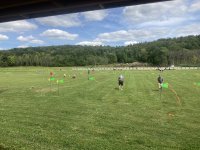Precision is relative to distance and which competitive shooting discipline so I would not agree that it is lost after 50 yards. Same for wind indicators the further the distance the more valuable they will become.
Louis, could you please explain your logic for this statement?
The reason that I am asking is that from practical experience I reckon that if a projectile is hit by a gust and deviates just after it leaves the muzzle then that deviation (angular) is there for the rest of the flight of the projectile.
On the other hand, if the projectile is almost at the target and gets hit by a gust then the deviation should be much less, resulting in a higher score.
I shoot rimfire comps at 50m and 100m and have consistently found this to hold up.
For best consistency I watch the flags for as long as possible before a match to determine the prevailing 'condition' when all flags are aligned and during the shoot try to match that condition every time.
I am by no means an expert, so this is a genuine question to help me improve my technique.
Regards * doggie *


